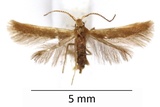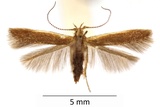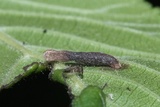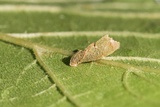Coleophora badiipennella (Duponchel, 1843) Species
Last modified: Dec. 5, 2024, 11:28 a.m.
This is a fairly rare and local species in Belgium. Populations are scarce, because of the Dutch elm (Ulmus) disease.
Details
- Classification
- Family: Coleophoridae > Genus: Coleophora > Species: Coleophora badiipennella
- Vernacular names
- Iepenkokermot (NL), Pale elm case-bearer (EN), Ulmen-Sackmotte (DE)
- First mention in Belgium
- De Fré Ch. 1860. Lépidoptères nouvellement découverts en Belgique. — Annales de la Société entomologique belge 4: 113–115. On page 114 (as Coleophora badiipennella. F. V. R.). view page
- Status
-
Native
Distribution
Case
The final spatula-shaped case is a small, laterally compressed, and bi-valved one having a strikingly broad rear end and measures 5–6 mm. It is constructed by the larva from a leaf fragment cut from the hostplant and its dorsal keel often shows some serrations which are the remnants of the leaf edge. The mouth angle is 0–10°.
See also bladmineerders.be.
Bionomics
The eggs are deposited on the underside of a leaf. The juvenile larvae mine inside a straight gallery, about 10–15 mm in length before they start constructing a case.
The larvae are full-grown in September or October. In springtime, after hibernation, they still resume feeding before pupating inside their case in May or June.
Flight periods
The moths fly in one generation in June and July.




